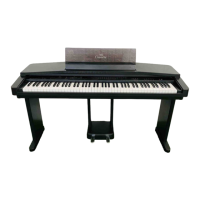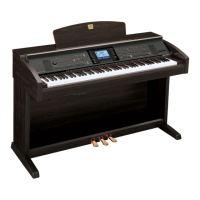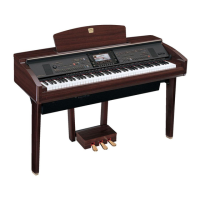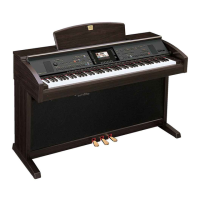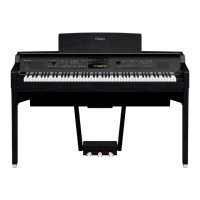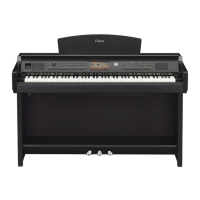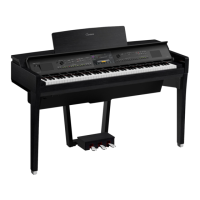Do you have a question about the Yamaha Clavinova CVP-35 and is the answer not in the manual?
Verify local AC mains voltage matches the voltage specified on the name plate.
Follow basic precautions when using electronic products, including handling and environment.
Essential guidelines for operation, maintenance, and potential hazards.
How to select voices numbered 13 through 53 using buttons.
Adjusting keyboard pitch and fine-tuning overall pitch.
Setting keyboard response to HARD, MEDIUM, or SOFT.
Defining split key and adjusting volume balance between voices.
Controls for keyboard volume, vibrato, pitch bend, and expression.
Various ways to start the rhythm playback, including intro and synchronized starts.
Using the ABC feature for automatic accompaniment.
Protecting the instrument from heat, dust, moisture, and damage.
Warnings about power connections, internal circuitry, and interference.
Identification of the main keyboard unit and its primary controls.
Identifying various selectors, buttons, and displays on the keyboard.
Basic steps to select and play a single voice on the keyboard.
How to play two voices simultaneously across the keyboard.
How to divide the keyboard into two different voice sections.
Instructions for selecting and playing rhythm styles.
Using the ABC feature for automatic accompaniment.
Using ABC with automatic harmonization for solo performances.
Detailed explanation of starting rhythm patterns with various options.
Synchronizing rhythm starts and using automatic fills.
How to stop rhythm playback and use the built-in metronome.
Details on various jacks for audio output and MIDI communication.
Instructions for setting up the music stand and operating the power switch.
How to adjust the overall and accompaniment volume levels.
Using volume controls for vibrato, pitch bend, and expression.
Information about the Clavinova's built-in audio output capabilities.
Guide to accessing and listening to the instrument's demonstration songs.
Methods for selecting from the instrument's extensive voice library.
A comprehensive list of available voices and their ranges.
Mapping of keys to drum and percussion instruments.
How to play two voices simultaneously across the keyboard.
How to divide the keyboard into two different voice sections.
Adjusting volume balance in split mode and pedal functions.
Understanding polyphony limits and touch response.
Detailed use of damper, soft, and multi-function pedals.
Adjusting how hard keys must be pressed for volume.
Shifting the entire keyboard pitch up or down.
Adjusting the overall pitch and understanding the pitch display.
Choosing rhythm styles and adjusting their tempo.
Methods for initiating rhythm playback, including intro and fill-ins.
Synchronizing rhythm starts and using automatic fills.
How to stop rhythm playback and use the built-in metronome.
Simplified chord input for automatic accompaniment.
Playing chords manually for automatic accompaniment.
Using ABC with chords detected anywhere on the keyboard.
Adjusting volumes for rhythm, chords, and bass parts.
Setting the keyboard split point for ABC modes.
Adding harmony to melodies for solo performances.
How to record musical performances using the built-in sequencer.
Playing back recorded tracks and erasing them.
Understanding memory limits and data retention.
Understanding MIDI and how to access its functions on the CVP-35.
Configuring MIDI channels for transmitting and receiving data.
Managing local keyboard control and program change messages.
Controlling effects and using the multi-timbre mode.
Transmitting left/right keyboard sections on different MIDI channels.
Synchronizing rhythm and ABC timing with external MIDI clocks.
Transmitting panel settings and dumping performance memory data.
Solutions for common problems like no sound or interference.
Information on available accessories and expander modules.
Technical data formats for voices, notes, and control messages.
Technical data formats for control changes and pitch bending.
Data formats for system realtime and exclusive messages.
Technical data formats for special messages like tempo and split.
Data formats for panel dump requests and general messages.
Steps to open the box and verify all parts are present.
Instructions for attaching side panels and feet to the stand.
Securing the side panels to the main center panel.
Installing the front support bracket between the side panels.
Instructions for attaching side panels and feet to the stand.
Securing the side panels to the main center panel.
Installing the front support bracket between the side panels.
Lowering and securing the main keyboard unit onto the stand.
Connecting the pedal assembly to the keyboard and stand.
Setting the pedal assembly's stability adjusters for proper operation.
Lowering and securing the main keyboard unit onto the stand.
Connecting the pedal assembly to the keyboard and stand.
Setting the pedal assembly's stability adjusters for proper operation.
Details on the keyboard type and tone generation system.
Lists available voices, controls, and rhythm styles.
Specifications for percussion, performance memory, and pedals.
Details on jacks, input/output, amplifier, speakers, and dimensions.
Diagrams for playing major and minor chords in root position.
Diagrams for playing seventh and minor seventh chords.
Diagrams for playing major seventh and minor major seventh chords.
Diagrams for playing augmented and diminished chords.
Diagrams for playing sixth and suspended fourth chords.
Diagrams for playing flat five chords with seventh.
Diagrams for half diminished and minor sixth chords.
Diagrams for seventh suspended fourth and major flat five chords.
Diagrams for minor and seventh flat five chords.
Diagrams for seventh sharp five and major seventh sharp five chords.
MIDI channel configuration and mode settings.
MIDI data formats for notes, velocity, and control changes.
MIDI data formats for program changes and system messages.
Crucial information regarding FCC compliance and modifications.
Information on the location and details of the product's nameplate.
Statements regarding compliance with regulations in Germany, UK, Canada, and Europe.
Verify local AC mains voltage matches the voltage specified on the name plate.
Follow basic precautions when using electronic products, including handling and environment.
Essential guidelines for operation, maintenance, and potential hazards.
How to select voices numbered 13 through 53 using buttons.
Adjusting keyboard pitch and fine-tuning overall pitch.
Setting keyboard response to HARD, MEDIUM, or SOFT.
Defining split key and adjusting volume balance between voices.
Controls for keyboard volume, vibrato, pitch bend, and expression.
Various ways to start the rhythm playback, including intro and synchronized starts.
Using the ABC feature for automatic accompaniment.
Protecting the instrument from heat, dust, moisture, and damage.
Warnings about power connections, internal circuitry, and interference.
Identification of the main keyboard unit and its primary controls.
Identifying various selectors, buttons, and displays on the keyboard.
Basic steps to select and play a single voice on the keyboard.
How to play two voices simultaneously across the keyboard.
How to divide the keyboard into two different voice sections.
Instructions for selecting and playing rhythm styles.
Using the ABC feature for automatic accompaniment.
Using ABC with automatic harmonization for solo performances.
Detailed explanation of starting rhythm patterns with various options.
Synchronizing rhythm starts and using automatic fills.
How to stop rhythm playback and use the built-in metronome.
Details on various jacks for audio output and MIDI communication.
Instructions for setting up the music stand and operating the power switch.
How to adjust the overall and accompaniment volume levels.
Using volume controls for vibrato, pitch bend, and expression.
Information about the Clavinova's built-in audio output capabilities.
Guide to accessing and listening to the instrument's demonstration songs.
Methods for selecting from the instrument's extensive voice library.
A comprehensive list of available voices and their ranges.
Mapping of keys to drum and percussion instruments.
How to play two voices simultaneously across the keyboard.
How to divide the keyboard into two different voice sections.
Adjusting volume balance in split mode and pedal functions.
Understanding polyphony limits and touch response.
Detailed use of damper, soft, and multi-function pedals.
Adjusting how hard keys must be pressed for volume.
Shifting the entire keyboard pitch up or down.
Adjusting the overall pitch and understanding the pitch display.
Choosing rhythm styles and adjusting their tempo.
Methods for initiating rhythm playback, including intro and fill-ins.
Synchronizing rhythm starts and using automatic fills.
How to stop rhythm playback and use the built-in metronome.
Simplified chord input for automatic accompaniment.
Playing chords manually for automatic accompaniment.
Using ABC with chords detected anywhere on the keyboard.
Adjusting volumes for rhythm, chords, and bass parts.
Setting the keyboard split point for ABC modes.
Adding harmony to melodies for solo performances.
How to record musical performances using the built-in sequencer.
Playing back recorded tracks and erasing them.
Understanding memory limits and data retention.
Understanding MIDI and how to access its functions on the CVP-35.
Configuring MIDI channels for transmitting and receiving data.
Managing local keyboard control and program change messages.
Controlling effects and using the multi-timbre mode.
Transmitting left/right keyboard sections on different MIDI channels.
Synchronizing rhythm and ABC timing with external MIDI clocks.
Transmitting panel settings and dumping performance memory data.
Solutions for common problems like no sound or interference.
Information on available accessories and expander modules.
Technical data formats for voices, notes, and control messages.
Technical data formats for control changes and pitch bending.
Data formats for system realtime and exclusive messages.
Technical data formats for special messages like tempo and split.
Data formats for panel dump requests and general messages.
Steps to open the box and verify all parts are present.
Instructions for attaching side panels and feet to the stand.
Securing the side panels to the main center panel.
Installing the front support bracket between the side panels.
Instructions for attaching side panels and feet to the stand.
Securing the side panels to the main center panel.
Installing the front support bracket between the side panels.
Lowering and securing the main keyboard unit onto the stand.
Connecting the pedal assembly to the keyboard and stand.
Setting the pedal assembly's stability adjusters for proper operation.
Lowering and securing the main keyboard unit onto the stand.
Connecting the pedal assembly to the keyboard and stand.
Setting the pedal assembly's stability adjusters for proper operation.
Details on the keyboard type and tone generation system.
Lists available voices, controls, and rhythm styles.
Specifications for percussion, performance memory, and pedals.
Details on jacks, input/output, amplifier, speakers, and dimensions.
Diagrams for playing major and minor chords in root position.
Diagrams for playing seventh and minor seventh chords.
Diagrams for playing major seventh and minor major seventh chords.
Diagrams for playing augmented and diminished chords.
Diagrams for playing sixth and suspended fourth chords.
Diagrams for playing flat five chords with seventh.
Diagrams for half diminished and minor sixth chords.
Diagrams for seventh suspended fourth and major flat five chords.
Diagrams for minor and seventh flat five chords.
Diagrams for seventh sharp five and major seventh sharp five chords.
MIDI channel configuration and mode settings.
MIDI data formats for notes, velocity, and control changes.
MIDI data formats for program changes and system messages.
Crucial information regarding FCC compliance and modifications.
Information on the location and details of the product's nameplate.
Statements regarding compliance with regulations in Germany, UK, Canada, and Europe.
| Type | Digital Piano |
|---|---|
| Sound Source | AWM (Advanced Wave Memory) |
| Effects | Reverb, Chorus |
| Display | LCD |
| Sequencer | Yes |
| Amplifier | 20W x 2 |
| Keyboard | 88 keys |
| Connectivity | MIDI |
| Pedals | Damper, Soft, Sostenuto |
| MIDI | In/Out |
| Rhythms | 100 |
| Polyphony | 32-note |
| Styles | 100 styles |

